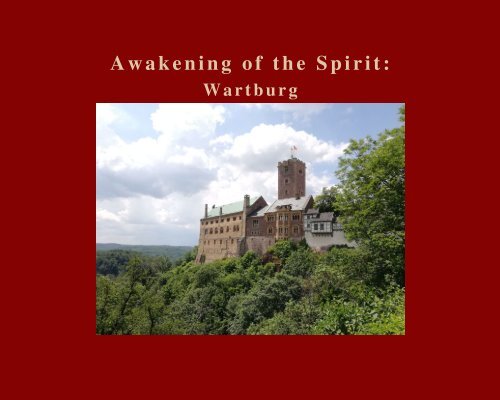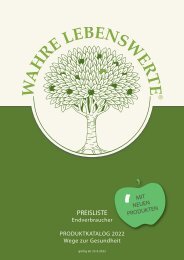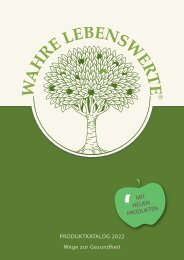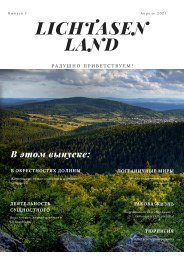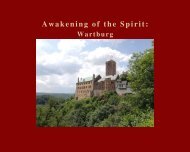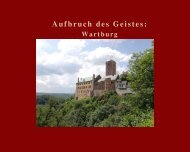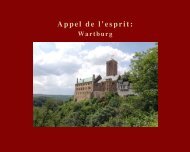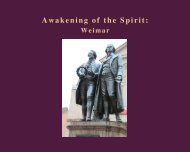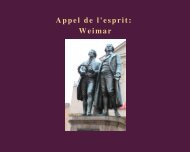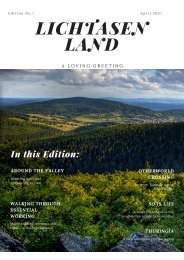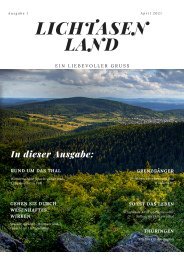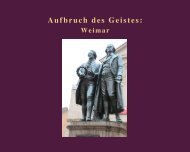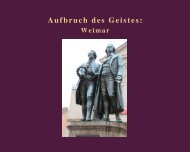Awakening of the Spirit: Wartburg
You also want an ePaper? Increase the reach of your titles
YUMPU automatically turns print PDFs into web optimized ePapers that Google loves.
A w a k e n i n g o f t h e S p i r i t :<br />
W a r t b u r g
H i g h a b o v e<br />
E i s e n a c h , a b o v e<br />
t h e d a r k f o r e s t s<br />
o f T h u r i n g i a ,<br />
" t h e g r e e n h e a r t<br />
o f G e r m a n y " ,<br />
r i s e s t h e<br />
i m p o s i n g<br />
s i l h o u e t t e o f<br />
W a r t b u r g C a s t l e ,<br />
" t h e m o s t<br />
G e r m a n " o f a l l<br />
c a s t l e s .
1 0 0 0 y e a r s o f t u r b u l e n t h i s t o r y h a v e<br />
s h a p e d t h i s s i t e , w h i c h u n i t e s t h e<br />
m o s t d i v e r s e c u r r e n t s o f s p i r i t u a l<br />
a n d c u l t u r a l l i f e i n o u r c o u n t r y .
B u t w h a t i s t h e m a g i c o f t h e W a r t b u r g ,<br />
w h o s e s i g h t s o c a p t i v a t e s t h e b e h o l d e r ?
The most illustrious names in German spiritual life are associated with this site:<br />
Johann Wolfgang von Goe<strong>the</strong> was enthralled by <strong>the</strong> ancient building in its<br />
picturesque setting, which he visited several times and captured in drawings.<br />
King Ludwig II <strong>of</strong> Bavaria was also captivated by <strong>the</strong> aura <strong>of</strong> <strong>the</strong> place. During<br />
his visit to <strong>Wartburg</strong> Castle in 1867, he asked to be allowed to visit <strong>the</strong><br />
magnificent halls alone, so that he could let <strong>the</strong> flood <strong>of</strong> impressions take effect on<br />
him without being influenced.<br />
And Richard Wagner found <strong>the</strong> appearance <strong>of</strong> <strong>the</strong> myth-laden fortress a "ray <strong>of</strong><br />
light" and made it <strong>the</strong> setting for his Tannhäuser.
M a r t i n L u t h e r , f l e e i n g f r o m t h e e m p e r o r ' s<br />
h e n c h m e n , h a d a l r e a d y f o u n d r e f u g e<br />
w i t h i n t h e w a l l s o f t h e f o r t r e s s .
"As soon as <strong>the</strong> gold in <strong>the</strong> casket rings,<br />
<strong>the</strong> rescued soul to heaven springs"<br />
<br />
i s s a i d t o h a v e b e e n p a i n t e d o n t h e m o n e y b o x t h a t t h e<br />
i n d u l g e n c e p r e a c h e r a n d D o m i n i c a n m o n k J o h a n n T e t z e l<br />
u s e d i n t h e M a g d e b u r g r e g i o n a t t h e b e g i n n i n g o f t h e 1 6 t h<br />
c e n t u r y o n b e h a l f o f P o p e L e o X a n d C a r d i n a l A l b r e c h t o f<br />
B r a n d e n b u r g t o c o l l e c t t h e p r o c e e d s o f h i s d e a l i n g s w i t h<br />
t h e s a l v a t i o n o f t h e f a i t h f u l .<br />
F o r g i v e n e s s o f s i n s a g a i n s t p a y m e n t , b a s e d o n f i x e d<br />
t a r i f f s . F o r e x a m p l e , a m u r d e r c o u l d b e a t o n e d f o r w i t h<br />
f o u r d u c a t s . E v e n a d o c u m e n t t h a t g u a r a n t e e d f u l l<br />
f o r g i v e n e s s o f s i n s f o r r e l a t i v e s w h o h a d a l r e a d y d i e d w a s<br />
a v a i l a b l e f o r p a y m e n t o f t h e c o r r e s p o n d i n g s u m .<br />
S o u r c e E n g l i s h q u o t e :<br />
J o h a n n T e t z e l - C a l l i p e d i a ( m i r a h e z e . o r g )
A f t e r f u t i l e p r o t e s t s a g a i n s t t h e s e i m m o d e r a t e<br />
e x c e s s e s , M a r t i n L u t h e r r e s o r t e d t o a d r a s t i c m e a n s :<br />
a c c o r d i n g t o t r a d i t i o n , a t d a w n o n 3 1 O c t o b e r 1 5 1 7<br />
h e n a i l e d a d o c u m e n t w i t h 9 5 t h e s e s a g a i n s t<br />
e c c l e s i a s t i c a l a b u s e s t o t h e d o o r o f t h e c a s t l e<br />
c h u r c h i n W i t t e n b e r g . W i t h t h i s a c t t h e A u g u s t i n i a n<br />
m o n k h e r a l d e d a n e w e r a : T h e b e g i n n i n g o f t h e<br />
R e f o r m a t i o n , t h e r e n e w a l m o v e m e n t o f t h e e n t i r e<br />
c e n t u r y .<br />
O n e o f t h e 9 5 t h e s e s r e a d :<br />
<br />
" T h e t r u e t r e a s u r e o f t h e C h u r c h i s t h e M o s t H o l y<br />
G o s p e l o f t h e g l o r y a n d g r a c e o f G o d . "<br />
Source German quote : https://de.wikipedia.org/wiki/95_Thesen
The disputes with <strong>the</strong> German dignitaries and <strong>the</strong> Pope in Rome,<br />
Leo X, ultimately led to <strong>the</strong> event that made Martin Lu<strong>the</strong>r worldfamous:<br />
On 18 April 1521, in <strong>the</strong> presence <strong>of</strong> Emperor Charles V, before<br />
<strong>the</strong> highest representatives <strong>of</strong> <strong>the</strong> secular and ecclesiastical<br />
powers, he proclaimed <strong>the</strong> historic sentence:<br />
<br />
"Here I stand. I have no o<strong>the</strong>r choice.<br />
<br />
God help me!<br />
Amen."<br />
<br />
The emperor <strong>the</strong>n imposed <strong>the</strong> imperial ban on <strong>the</strong> monk,<br />
which was practically tantamount to a death sentence.
"My<br />
conscience<br />
remains<br />
captive<br />
in God's<br />
Word"
"My conscience remains captive in God's Word"<br />
<br />
This quotation from <strong>the</strong> original wording <strong>of</strong> Lu<strong>the</strong>r's speech<br />
sounds somewhat less imposing than <strong>the</strong> historical saying,<br />
but it reveals what he was actually thinking:<br />
The willingness, in his refusal to bow to <strong>the</strong> teachings <strong>of</strong> <strong>the</strong><br />
ecclesiastical authorities, which he recognised as wrong, and<br />
thus ra<strong>the</strong>r lose life and limb than renounce allegiance to<br />
God's Word, which would have meant placing himself<br />
outside God's laws.<br />
That is how powerful <strong>the</strong> voice <strong>of</strong> his conscience had<br />
become.
Perhaps it is this attitude that still motivates<br />
millions <strong>of</strong> people today to follow <strong>the</strong> traces<br />
<strong>of</strong> his work?<br />
Lu<strong>the</strong>r's study at <strong>Wartburg</strong> Castle.
For, perhaps, each <strong>of</strong> us in our lives is sometimes faced<br />
with <strong>the</strong> decision to give in to <strong>the</strong> powerful pressure <strong>of</strong><br />
family, hierarchical, governmental or ecclesiastical<br />
authorities or to follow what we have recognised in our<br />
inner being as right.
On 4 May 1521, Lu<strong>the</strong>r, who was practically outlawed after <strong>the</strong> imposition<br />
<strong>of</strong> <strong>the</strong> imperial ban and could be killed by anyone, arrived at <strong>Wartburg</strong><br />
Castle disguised as "Junker Jörg".
T h e r e , i n j u s t 1 0 w e e k s , h e<br />
t r a n s l a t e d t h e N e w T e s t a m e n t<br />
f r o m H e b r e w a n d G r e e k i n t o<br />
G e r m a n . N o h i g h o f f i c e<br />
G e r m a n , i n t e n d e d o n l y f o r<br />
s c h o l a r s , a s b e f o r e , b u t M a r t i n<br />
L u t h e r f o r m e d a l a n g u a g e t h a t<br />
w a s u n d e r s t o o d b y e v e r y o n e .<br />
A t t h e s a m e t i m e , h e c r e a t e d a<br />
u n i f i e d l a n g u a g e o u t o f t h e<br />
c o u n t l e s s i n d i v i d u a l d i a l e c t s<br />
a n d t h u s p r e p a r e d t h e g r o u n d<br />
f o r t h e g r e a t a g e o f t h e " p o e t s<br />
a n d t h i n k e r s " .
"For Thine is<br />
<strong>the</strong> kingdom, <strong>the</strong> power<br />
and <strong>the</strong> glory,<br />
for ever and ever.<br />
Amen!"<br />
With this jubilant confession, Martin Lu<strong>the</strong>r completes his translation <strong>of</strong> <strong>the</strong><br />
Lord's Prayer and thus takes up an established custom, for in Judaism and at<br />
<strong>the</strong> time <strong>of</strong> Jesus, too, <strong>the</strong> prayers ended with praise in honour <strong>of</strong> <strong>the</strong> Creator<br />
and Supreme Ruler <strong>of</strong> all worlds.
But it is not only this experience that is etched<br />
into <strong>the</strong> walls <strong>of</strong> <strong>the</strong> fortress.
On <strong>the</strong> occasion <strong>of</strong> <strong>the</strong> restoration <strong>of</strong> <strong>the</strong> historical sites in <strong>the</strong> 19th<br />
century, <strong>the</strong> painter Moritz von Schwind revived <strong>the</strong> glorious history<br />
<strong>of</strong> <strong>the</strong> past since <strong>the</strong> founding <strong>of</strong> <strong>Wartburg</strong> Castle by Ludwig <strong>the</strong><br />
Leaper <strong>of</strong> 1067 in colourful frescoes.
At <strong>the</strong> same time <strong>the</strong> murals tell <strong>the</strong> story<br />
<strong>of</strong> ano<strong>the</strong>r rebel:<br />
<br />
Elisabeth <strong>of</strong> Thuringia (1207 - 1231), who was later canonised, preferred a<br />
life <strong>of</strong> renunciation and poverty to <strong>the</strong> courtly customs <strong>of</strong> her nobility.<br />
Elisabeth, daughter <strong>of</strong> King Andrew II <strong>of</strong> Hungary, was married to<br />
Landgrave Ludwig IV <strong>of</strong> Thuringia at <strong>the</strong> age <strong>of</strong> 14. She refused to adorn<br />
herself with <strong>the</strong> insignia <strong>of</strong> her high position, preferring to devote her life to<br />
caring for <strong>the</strong> poor and needy, entirely in <strong>the</strong> spirit <strong>of</strong> her great role model,<br />
Francis <strong>of</strong> Assisi, and in accordance with <strong>the</strong> saying that has come down to<br />
us from her:<br />
<br />
"How can I wear a golden crown when <strong>the</strong> Lord wears a crown <strong>of</strong><br />
thorns!"<br />
<br />
Source <strong>of</strong> quote in German: https://www.aphorismen.de/zitat/90569
Elisabeth's Bower
One <strong>of</strong> <strong>the</strong> greatest myths in German history is <strong>the</strong> legendary Singers'<br />
quarrel at <strong>Wartburg</strong> Castle, which is said to have begun in 1206.<br />
<br />
<br />
<br />
Moritz von Schwind artist QS:P170,Q551901, <strong>Wartburg</strong> Saengerwettstreit, als gemeinfrei gekennzeichnet, Details auf Wikimedia Commons<br />
<br />
Fresco by Moritz von Schwind.
Above all, <strong>the</strong> participation <strong>of</strong> <strong>the</strong> greatest minnesingers<br />
and poets <strong>of</strong> <strong>the</strong>ir time, such as Walter von der Vogelweide<br />
or Wolfram von Eschenbach, lends <strong>the</strong> event <strong>of</strong> <strong>the</strong> Singers'<br />
quarrel a special radiance.<br />
For during this stay at <strong>Wartburg</strong> Castle, Wolfram von<br />
Eschenbach probably also wrote large parts <strong>of</strong> his<br />
most famous work, <strong>the</strong> verse novel "Parzival", in<br />
which he continued and expanded <strong>the</strong> <strong>the</strong>me <strong>of</strong> <strong>the</strong><br />
French poet Chrétien de Troyes' "Perceval, <strong>the</strong> Story<br />
<strong>of</strong> <strong>the</strong> Grail".
Source: Bibliothèque nationale de France<br />
http://expositions.bnf.fr/arthur/grand/fr_12577_018v.htm<br />
<br />
<br />
Arrival <strong>of</strong> Parzival at <strong>the</strong> Grail Castle. He receives <strong>the</strong> sword from <strong>the</strong> hands <strong>of</strong><br />
<strong>the</strong> Fisher King.
While in this period <strong>of</strong> <strong>the</strong> Crusades <strong>of</strong> <strong>the</strong> early Middle Ages <strong>the</strong><br />
elite <strong>of</strong> Christendom sought to force <strong>the</strong>ir way into Jerusalem<br />
through bloody battles, <strong>the</strong> knights and noblemen in <strong>the</strong> hymns<br />
and novels at <strong>Wartburg</strong> Castle sought to come closer to <strong>the</strong>ir ideal<br />
through a life pleasing to God.<br />
The heroes <strong>of</strong> <strong>the</strong>se poems seek not only glory and honour, but<br />
virtue and morality, purification and redemption....in <strong>the</strong> quest for<br />
<strong>the</strong> Holy Grail.<br />
For, even if he feels he can never fully grasp <strong>the</strong> high,<br />
unattainable, <strong>the</strong> human spirit will always strive for it.
One <strong>of</strong> <strong>the</strong> first to be attracted by <strong>the</strong> representation <strong>of</strong> <strong>the</strong>se high<br />
ideals was King Ludwig II <strong>of</strong> Bavaria: In 1867, shortly after <strong>the</strong><br />
end <strong>of</strong> <strong>the</strong> restoration <strong>of</strong> <strong>the</strong> entire structure, he visited <strong>Wartburg</strong><br />
Castle and was so taken with <strong>the</strong> magnificent decoration <strong>of</strong> <strong>the</strong><br />
chambers and halls with <strong>the</strong>ir colourful frescoes, mosaics and<br />
golden columns that he had his planned Neuschwanstein Castle<br />
built on this model.
Richard Wagner<br />
<br />
As early as on his return journey from Paris, in 1842, when he<br />
caught sight <strong>of</strong> <strong>the</strong> silhouette <strong>of</strong> <strong>the</strong> fortress from afar,<br />
"unreachable, so close to heaven," <strong>the</strong> decision must have matured<br />
in Richard Wagner's mind to make <strong>the</strong> place <strong>the</strong> setting for his<br />
romantic opera Tannhäuser.<br />
With this stage work, which was also inspired by <strong>the</strong> singers'<br />
quarrel at <strong>Wartburg</strong> Castle, Wagner created a moving memorial to<br />
<strong>the</strong> noble contest <strong>of</strong> <strong>the</strong> 13th century.<br />
In particular, <strong>the</strong> festive hall in which regular performances <strong>of</strong><br />
"Tannhäuser" still take place today has thus gone down in history.
“Joyfully we welcome <strong>the</strong> noble hall…”<br />
<br />
("Tannhäuser" - Entry <strong>of</strong> <strong>the</strong> guests <strong>of</strong> <strong>the</strong> singers' quarrel into <strong>the</strong> banquet hall,<br />
Act 2, Scene 4 )
But it was again Richard Wagner who had taken up <strong>the</strong> <strong>the</strong>me <strong>of</strong> <strong>the</strong><br />
Grail quest from Wolfram's "Parzival" under a slightly different name<br />
and with an emphasis on religious motifs.<br />
As early as 1865, King Ludwig II <strong>of</strong> Bavaria had asked Wagner to<br />
realize <strong>the</strong> project.<br />
Thus, on 26 July 1882 <strong>the</strong> first performance <strong>of</strong> <strong>the</strong> Consecration play<br />
"Parsifal" took place in Bayreuth, composed by Richard Wagner, who<br />
understood like no o<strong>the</strong>r how to give voice to <strong>the</strong> human longing for<br />
<strong>the</strong> high, eternally unattainable:
With <strong>the</strong> exception <strong>of</strong> <strong>the</strong> images on pages 26 and 28 and <strong>the</strong> quotations:<br />
Photos and text – copyright © 2021 - Manfred Peter Luef - www.luef.co.at


